
Churches and Cathedrals of Manhattan, New York City - 8
Personal notes and information gleaned following a visit October 2003, and features only the churches which I discovered during my seven days in New York. The churches face in all sorts of directions, the descriptions that follow therefore have ritual directions which assumes the high altar is at the east end of the building. The churches are all Roman Catholic, unless otherwise mentioned, and are featured in the order I visited them.
Cathedral Church of St John the Divine (Episcopal) ( Amsterdam Avenue & W 112th Street)
(Prior to the visit I had just had a trip around Manhattan in a Helicopter, my first ever trip in such a machine! It was great.)
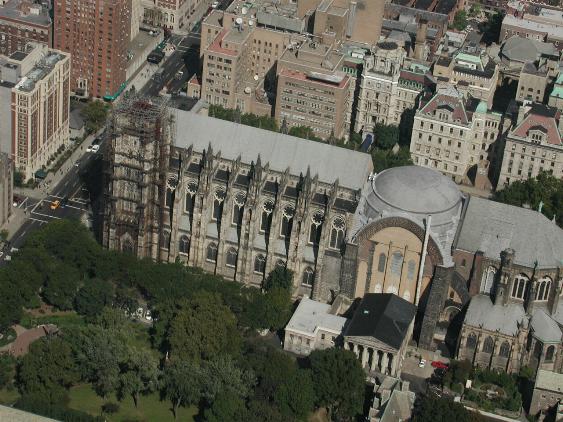 |
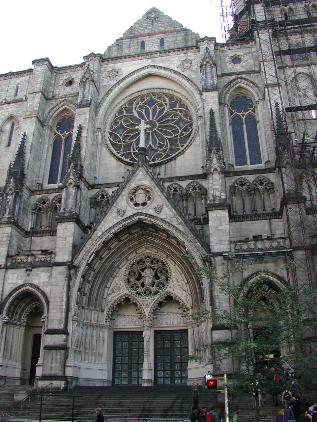 |
The cathedral could be described as a monumental folly. When, or if, completed it will be the largest cathedral in the world, but it is nowhere near finished. In fact it is a series of disjointed parts, as my (yes my) aerial photograph shows. The main problem has been the foundations, which had to be taken down over seventy feet before bedrock was found two years later, money disappearing literally into a gigantic hole in the ground. It also uses traditional building methods. I found it open, which it generally is 0900-1700.
The cathedral was begun in 1892 to the designs of Heins and LaFarge with a huge domed crossing, but by 1911 only the crossing and the choir were built. The style chosen was a Romanesque one, with tall close-set polished grey-granite piers in the apse, like the churches of the Auvergne in France. When work stopped the three remaining crossing arches were filled by temporary walls. The plans foundered and Ralph Adams Cram (from Boston) took over the project and altered the designs to form a Gothic church. Because of the width of the crossing the nave was given double aisles, and the style is French, lit by large clerestory windows in the inner aisles. Inside large multi-shafted piers alternate with slimmer piers in the nave. Oddly this largest chunk of the cathedral was built in just over nine years 1925-35, outfitting it taking a further four years. The eastern arm was then shut and Cram altered it 1939-41 to match the western half. However the high windows of the apse are lit artificially as this upper section is completely inside the original roof of the Heins & LaFarge choir. Money ran out during construction of the north transept which stands some forty feet high; it was covered to provide rooms and a shop but following a fire in December 2001 is once more open to the elements.
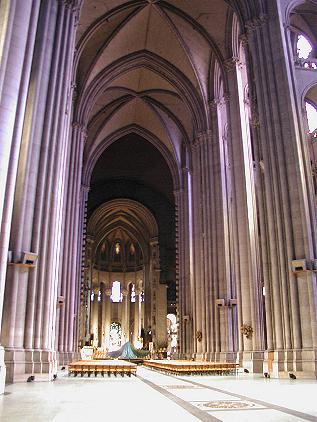 |
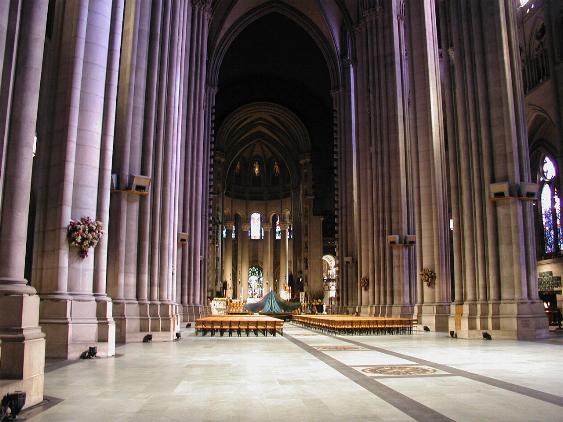 |
| The next wave of work began in
1978, with a drive to finish the west front and towers.
The SW tower began to rise above the west front in 1982
but has barely risen one stage by 2003. The stonemason
yards were quiet and appeared closed, so I presume work
has stopped again. The aim was to complete both towers to
celebrate 100 years in 1992. Inside less appears awry,
the vista stretches for 600 feet (180m), but the crossing
is like a dark hole in the centre: stand here and the
illlusion fails. My Eyewitness
Travel Guide : New York estimates
it will cost $400million to complete the cathedral
(transepts, west and central towers) and once the money
is raised a further fifty years to construct. Afterwards I enjoyed the fountain and statue of St George and the Dragon (I assume) in the grounds to the south. It was switched off, presumably saving money. |
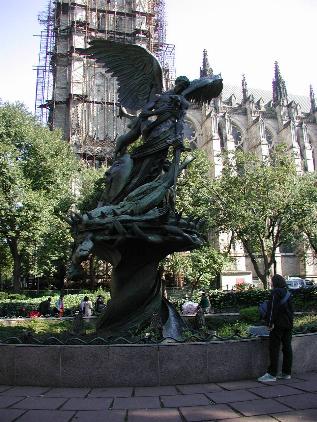 |
Notre Dame (405 W 114th Street)
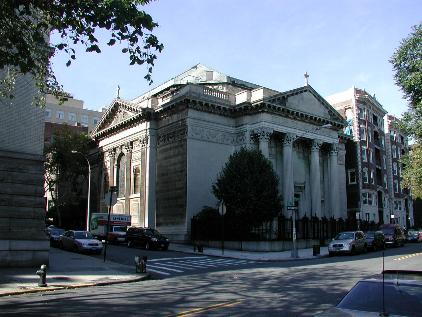 |
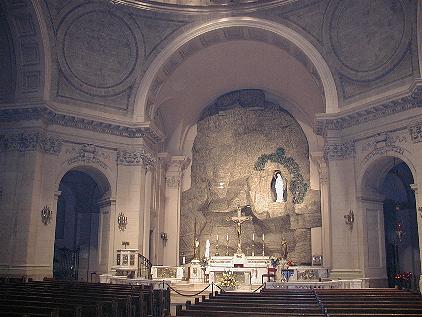 |
Started life as a chapel designed by Dans and Otto in 1910, which incorporated a replica of the Grotto at Lourdes. The grotto chapel was dedicated by Archbishop Farley (later Cardinal Farley) in October 1910 and the chapel was completed a year later. Very soon a larger church was required and Cross and Cross modelled the new structure after the Church of Saint Louis in Paris (Les Invalides). The building was dedicated in 1915 by Cardinal Farley who returned in 1916 to consecrate the grotto altar.
In 1919 work on the interior of the expanded church began in earnest and would continue for most of the next decade. The organ (built in Quebec by the Casavant Brothers) was installed in 1925, and two years later the main altar of Carrara marble arrived from France. The designer was Edmond Becker, who worked in white marble and gilt bronze, and created a matching altar, pulpit, and Communion rail. T When the altar was first displayed, observers were intrigued by the halos about the heads of Christ, His Mother and St John. These are made of enamel and are illuminated by electricity.
The plans to crown the church with a high dome as in Paris were finally abandoned in the 1960s and the current shallow dome and low roofline were constructed.
I found the church locked, but calling at the presbytery behind the church (connected by an openwork semi-circular cloister) was fruitful and the church was kindly opened for me by the priest. The interior space is awesome and the finished stone and ornate detail contrasts sharply with the replica rock face behind the main altar.
COLUMBIA UNIVERSITY St Paul's Chapel (Inter-denominational) (On campus between W 114th & W120th Streets / Broadway and Amsterdam Avenue)
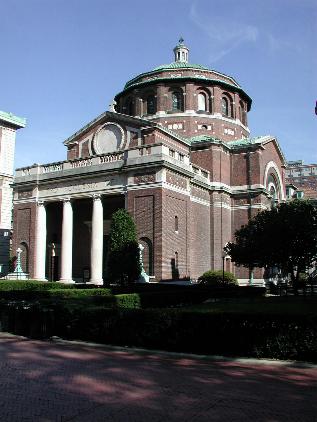 |
In the middle of Columbia Campus, alongside
the impressive library, yet in a peaceful garden setting.
The chapel was begun in 1904 and finished in 1907. The architects were Howells & Stokes and the exterior recalls the Byzantine style of the orthodox church and that to be found in eastern Italy e.g. Ravenna. The interior is famed for excellent acoustics (I tried a loud cough!) and fine woodwork, said to be modelled on that at San Croce in Florence / Firenze Italy. |
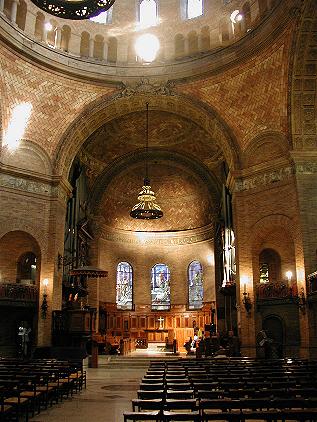 |
Riverside Church (Baptist affiliated) (490 Riverside Drive at W122nd Street)
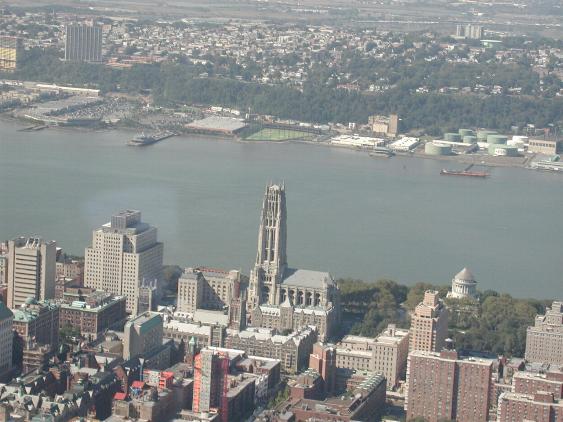 |
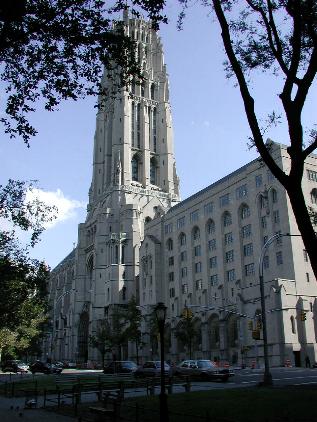 |
In comparison to the Episcopal cathedral, this church largely funded by John D Rockefeller Jr was built with indecent haste! It was under construction 1927-31. The tower is 392 feet high and contains 74 bells and four lifts (or elevators more correctly here). The inspiration is France, the construction American with steel framing. But it works, and is awesome. I first saw it "in action" on a Sunday morning from the gallery on the fourth floor (view below right, retaken without the choir congregation and ministers on my second visit) but the whole complex bustles with people even in the week. It stands facing Riverside Park alongside the Hudson River and has Grant's Tomb as a neighbour to the north and the Union Theological Seminary to the east with a couple of Perpendicular English style towers which are totally dominated by their newer neighbour. (see my aerial photo above)
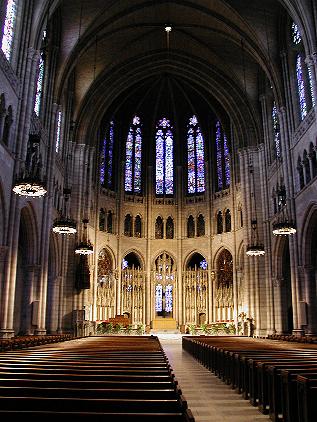 |
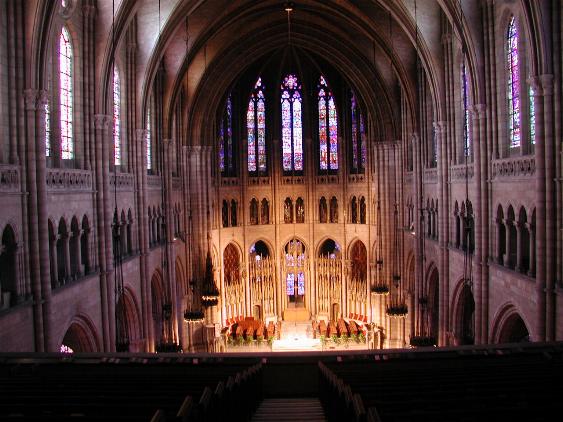 |
| The interior is 100 feet high and the nave is
89 feet wide. The west wall has two galleries entered
from the second and fourth floors. Above these is a
sculpture by Jacob Epstein "Christ in Majesty".
The arches of the apse have a fine fragile-looking stone
screens, contrasting with the architecture above and
around. To the west of the tower within the complex of ancillary building is this chapel, supposedly modelled on the C12 nave of St Nazaire at Carcassonne. It is in contrast to the airy Gothic of the main church, but is as large as many churches in England. I found the church open on both days but the Riverside Drive entrance is closed on weekdays - so enter via a cloister walk from Claremont Avenue. Remember to sign in at the desk and get a visitors sticker to wear! Busy though the place was I had the main church entirely to myself. |
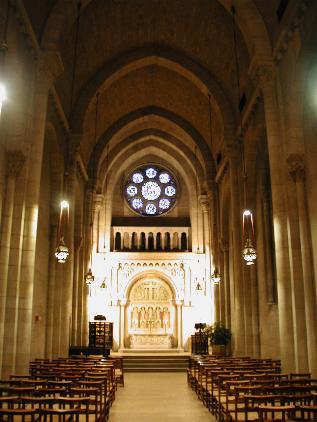 |
<BACK> <MANHATTAN INDEX> <NEXT>
page updated 30th August 2005